Every year, millions of lives are lost to diseases that could have been treated successfully if detected earlier. According to the World Health Organization, nearly 10 million people died from cancer in 2020 alone, with many of these deaths potentially preventable through early detection. Artificial intelligence is now emerging as a powerful tool in the fight against late diagnosis, using sophisticated algorithms to analyze vast amounts of medical data and identify disease markers long before symptoms become apparent.
As healthcare systems worldwide struggle with the burden of treating advanced diseases, AI early disease detection technologies offer a promising path forward—one that could fundamentally transform our approach from reactive treatment to proactive prevention, ultimately saving countless lives in the process.
How AI Detects Diseases Early
Artificial intelligence excels at pattern recognition—a capability that makes it particularly valuable for early disease detection. Unlike human observers who may miss subtle abnormalities, AI can consistently identify minute changes in medical data that often signal the earliest stages of disease development.
Pattern Recognition in Medical Imaging
One of the most promising applications of AI in early disease detection involves analyzing medical images. Advanced algorithms can examine X-rays, MRIs, CT scans, and other imaging modalities with remarkable precision, often detecting anomalies that human radiologists might miss.
For example, Google DeepMind’s AI system has demonstrated the ability to identify 50 different eye diseases from retinal scans with 94% accuracy, matching the performance of top specialists. Similarly, AI algorithms analyzing mammograms have shown the ability to reduce false negatives by 9.4% and false positives by 5.7% compared to human radiologists, potentially saving thousands of women from missed diagnoses or unnecessary procedures.

Predictive Analytics Using Patient Data
Beyond imaging, AI systems can analyze a patient’s genetic information, electronic health records, and lifestyle factors to predict disease risk with unprecedented accuracy. These predictive models identify patterns across thousands of variables that would be impossible for human clinicians to process manually.
For instance, researchers have developed AI algorithms that can predict the onset of Alzheimer’s disease up to six years before clinical diagnosis by analyzing subtle changes in brain scans and cognitive test results. Similarly, machine learning models analyzing ECG data have demonstrated the ability to identify patients at risk of developing atrial fibrillation—even when their heart rhythm appears normal to conventional analysis.
Data as the Fuel for AI
The effectiveness of AI in early disease detection depends entirely on the quality and quantity of data available for analysis. Modern healthcare systems generate enormous volumes of valuable information that, when properly leveraged, can power life-saving AI applications.

Types of Data Used in AI Analysis
Genomic Data
The human genome contains approximately 3 billion base pairs, providing a wealth of information about potential disease risks. AI algorithms can identify genetic mutations associated with various conditions, enabling early intervention before symptoms develop.
Electronic Health Records
Comprehensive patient histories contain valuable longitudinal data that AI can analyze to identify subtle trends and risk factors. By examining patterns across millions of records, algorithms can detect correlations that might escape human observation.
Wearable Device Data
The proliferation of smartwatches and fitness trackers has created new streams of continuous health data. AI systems can monitor these inputs for anomalies in heart rate, sleep patterns, and activity levels that might indicate developing health issues.
Medical Imaging
X-rays, MRIs, CT scans, and other imaging modalities provide rich visual data that AI can analyze pixel by pixel, identifying subtle changes invisible to the human eye.
Addressing Data Privacy Concerns
The use of sensitive health information in AI systems raises important privacy considerations. Healthcare organizations and technology developers are implementing various safeguards to protect patient data while still enabling life-saving analysis.

Key Data Protection Measures:
- Data anonymization techniques that strip personally identifiable information
- Federated learning approaches that allow AI to learn from data without centralizing sensitive information
- Strict access controls and encryption to protect data during transmission and storage
- Transparent consent processes that give patients control over how their data is used
Download Our Comprehensive Guide to AI in Healthcare
Get our free whitepaper exploring the latest advancements in AI early disease detection, including case studies, implementation strategies, and future trends.
Case Studies: AI Success Stories in Early Detection
Across multiple medical specialties, AI is already demonstrating remarkable success in identifying diseases at their earliest, most treatable stages. These real-world applications highlight the life-saving potential of artificial intelligence in healthcare.
Oncology: Detecting Cancer Before Symptoms Appear
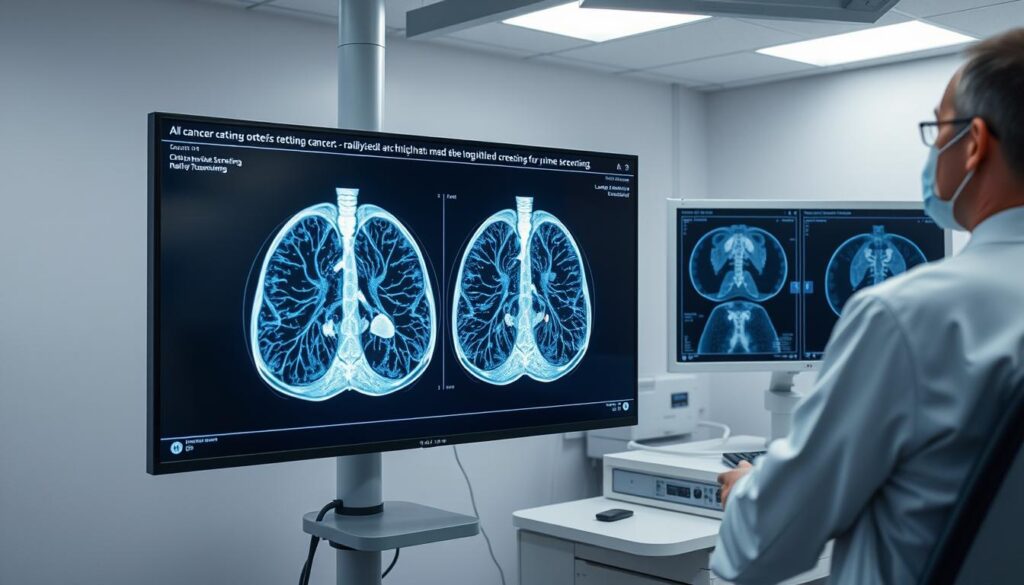
In oncology, early detection can dramatically improve survival rates. For lung cancer, the five-year survival rate jumps from just 5% for stage 4 diagnoses to 55% for stage 1. AI systems are now helping to identify cancers at these crucial early stages.
A landmark study published in Nature Medicine demonstrated that an AI algorithm could detect lung cancer from CT scans with 94% accuracy, outperforming experienced radiologists. The system identified subtle patterns indicative of early-stage tumors that human observers frequently missed, potentially saving thousands of lives through earlier intervention.
Similarly, IBM Watson for Oncology analyzes patient medical information against a vast database of medical literature to identify potential cancer markers and recommend personalized treatment options. This system helps oncologists stay current with the latest research while providing more accurate and timely diagnoses.
Cardiology: Predicting Heart Problems Before They Occur
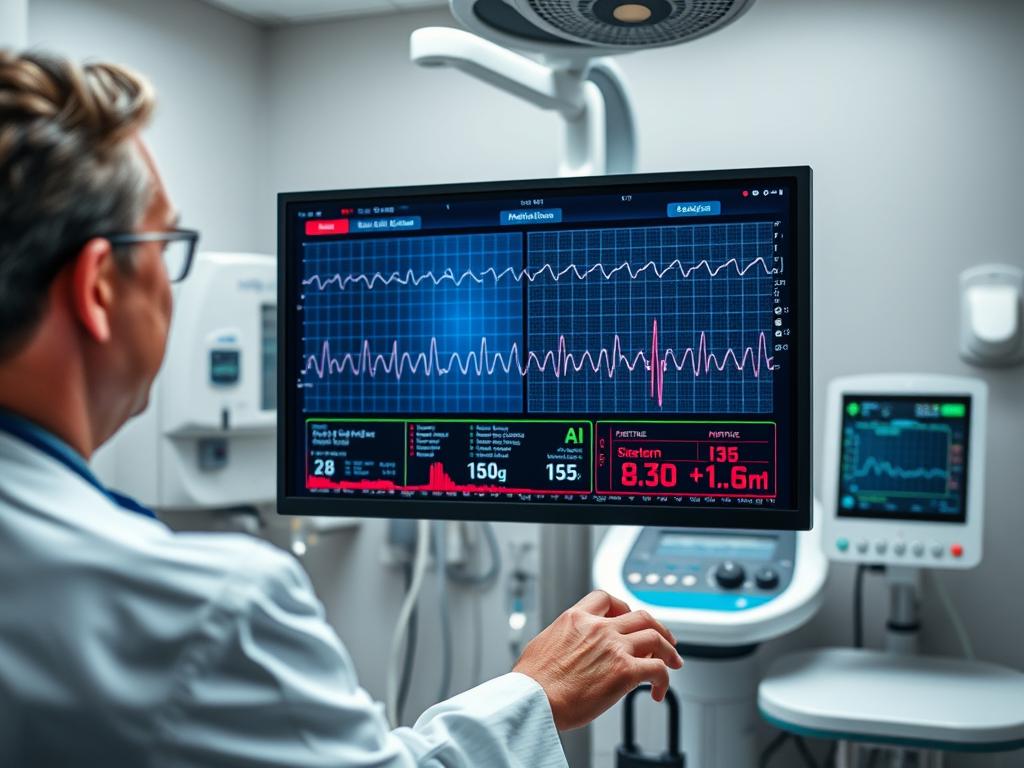
Cardiovascular disease remains the leading cause of death worldwide, with many fatal events occurring without warning. AI is changing this paradigm by identifying subtle cardiac risk factors long before a crisis occurs.
Researchers at the Mayo Clinic developed an AI algorithm that can analyze standard ECGs to detect asymptomatic left ventricular dysfunction—a condition that often leads to heart failure if untreated. The system identified patients at risk with 85% accuracy, allowing for preventive interventions that could significantly reduce mortality.
Another promising application uses AI to analyze retinal scans for signs of cardiovascular risk. By examining the blood vessels in the eye, these algorithms can predict a patient’s risk of heart attack or stroke with surprising accuracy, offering a non-invasive screening tool that could be widely deployed in routine eye exams.
Neurology: Early Detection of Cognitive Decline
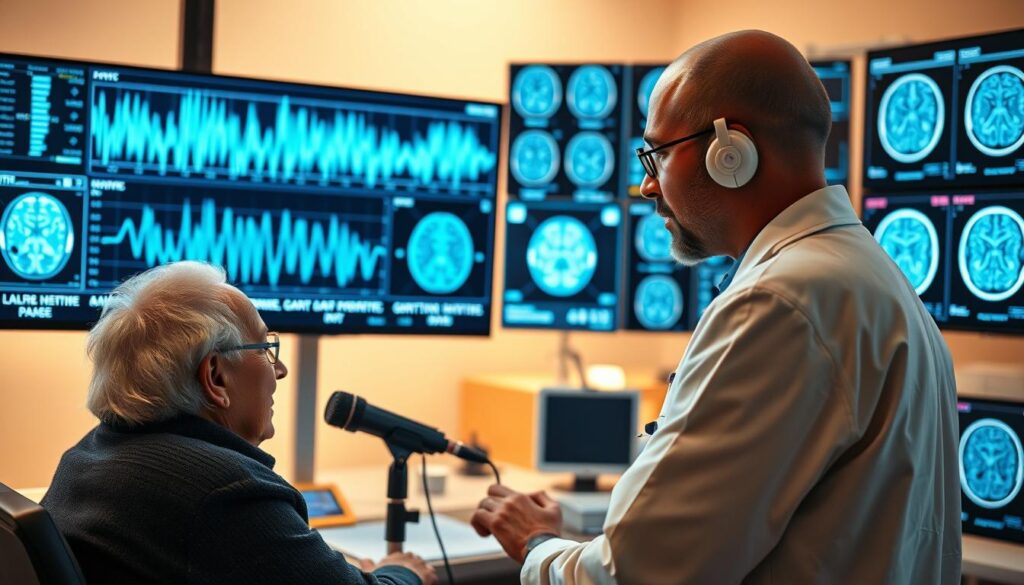
Neurological conditions like Alzheimer’s disease typically cause irreversible damage before symptoms become apparent. AI is offering new hope by detecting subtle cognitive changes years before clinical diagnosis.
Researchers at IBM and Pfizer developed an AI system that analyzes everyday speech patterns to identify linguistic changes associated with early-stage Alzheimer’s. In a study of healthy individuals, the algorithm predicted which participants would develop Alzheimer’s with 71% accuracy based solely on language samples collected years before diagnosis.
Similarly, AI algorithms analyzing brain MRIs can detect patterns associated with early-stage multiple sclerosis, allowing for earlier treatment that may slow disease progression and preserve neurological function.
Challenges and Ethical Considerations
Despite its tremendous potential, the implementation of AI in early disease detection faces several significant challenges that must be addressed to ensure these technologies benefit all patients equitably and ethically.
Bias in Training Data

AI systems are only as good as the data they’re trained on. If training datasets underrepresent certain populations—such as women, minorities, or the elderly—the resulting algorithms may perform poorly for these groups, potentially exacerbating existing healthcare disparities.
Addressing this challenge requires diverse, representative training datasets and rigorous testing across different demographic groups. Researchers are developing techniques to identify and mitigate bias in AI systems, ensuring these technologies work effectively for all patients regardless of age, gender, ethnicity, or socioeconomic status.
Regulatory Hurdles for Medical AI
The regulatory framework for AI in healthcare is still evolving, creating uncertainty for developers and healthcare providers. Questions about liability, approval processes, and ongoing monitoring of AI systems remain partially unresolved in many jurisdictions.
Regulatory bodies like the FDA in the United States are developing new approaches to evaluate and approve AI-based medical technologies, particularly those that continue to learn and evolve after deployment. These “adaptive” regulatory frameworks aim to balance innovation with patient safety, ensuring that AI systems remain effective and reliable throughout their lifecycle.
Building Patient Trust

For AI to reach its full potential in early disease detection, patients must trust these systems with their health data and medical decisions. Transparency about how AI works, what data it uses, and how it reaches its conclusions is essential for building this trust.
Healthcare providers play a crucial role in this process, serving as interpreters and guides who can explain AI findings in context and help patients understand the implications for their health. The most successful implementations of AI in healthcare maintain the human connection at the center of the patient experience, using technology to enhance rather than replace the provider-patient relationship.
“The promise of AI in healthcare is not to replace clinicians but to augment their capabilities, allowing them to detect diseases earlier, make more accurate diagnoses, and develop more effective treatment plans.”
The Future of AI in Preventive Healthcare
As AI technology continues to evolve, its applications in early disease detection are expanding rapidly, offering new possibilities for preventive healthcare that were unimaginable just a few years ago.
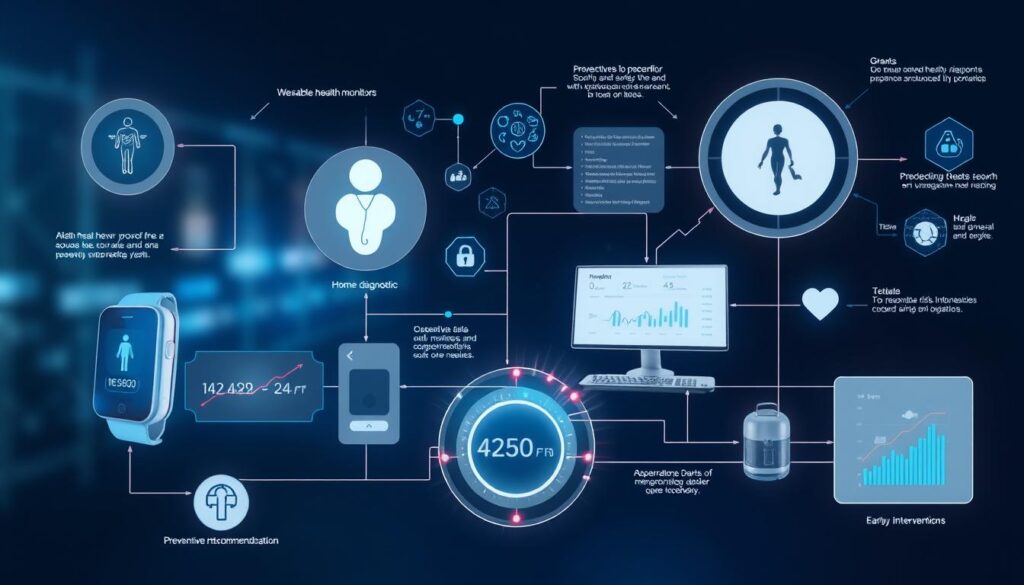
Emerging Technologies
One of the most promising developments is the combination of AI with liquid biopsy technology, which can detect circulating tumor DNA in blood samples. AI algorithms analyzing these blood tests can potentially identify multiple types of cancer at very early stages from a single blood draw, offering a revolutionary approach to cancer screening.
Similarly, advances in AI-powered analysis of the microbiome—the collection of microorganisms living in and on the human body—are opening new frontiers in disease prediction. Research suggests that changes in the microbiome may precede the development of conditions ranging from inflammatory bowel disease to diabetes and even certain neurological disorders.
Personalized Prevention Plans
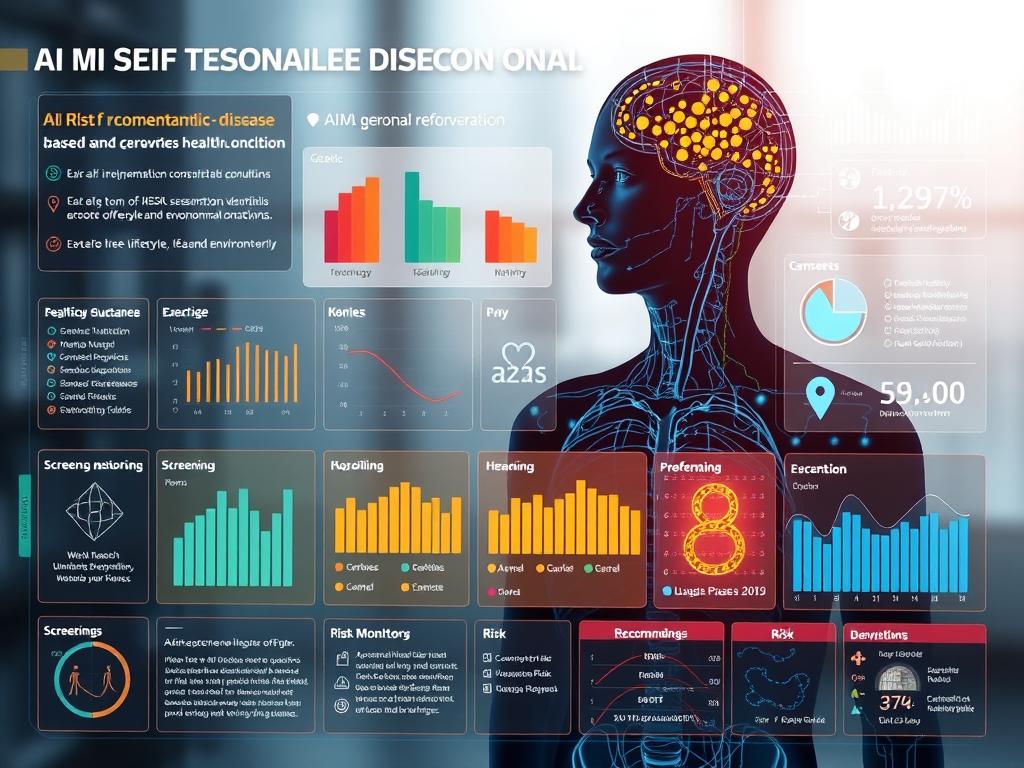
Perhaps the most transformative potential of AI lies in its ability to develop truly personalized prevention plans. By analyzing an individual’s genetic profile, medical history, lifestyle factors, and environmental exposures, AI can create customized recommendations for disease prevention that far exceed the one-size-fits-all approaches of traditional medicine.
These personalized plans might include tailored screening schedules, specific dietary and exercise recommendations, and targeted interventions based on an individual’s unique risk profile. As wearable devices and home monitoring technologies become more sophisticated, these prevention plans can continuously adapt based on real-time health data, creating a dynamic approach to disease prevention.
How accurate are AI diagnostic systems compared to human doctors?
Current AI systems for disease detection often match or exceed the accuracy of experienced medical specialists in specific, well-defined tasks. For example, AI algorithms for analyzing medical images have demonstrated accuracy rates of 90-95% in detecting conditions like diabetic retinopathy, certain cancers, and cardiovascular abnormalities, comparable to or better than human experts. However, AI excels at narrow, specific tasks rather than the broad diagnostic reasoning that physicians perform. The most effective approach combines AI analysis with human clinical judgment.
Will AI replace doctors in disease diagnosis?
AI is unlikely to replace doctors but will increasingly augment their capabilities. While AI excels at pattern recognition and data analysis, it lacks the holistic understanding, ethical judgment, and interpersonal skills that are essential to medical practice. The future of healthcare will likely involve collaborative intelligence, where AI handles routine screening and analysis, allowing physicians to focus on complex cases, treatment decisions, and the human aspects of patient care.
Stay Updated on AI Healthcare Innovations
Subscribe to our newsletter for the latest research, case studies, and breakthroughs in AI early disease detection and preventive healthcare.
Conclusion
Artificial intelligence is fundamentally transforming our approach to disease detection, shifting the paradigm from reactive treatment to proactive prevention. By analyzing vast amounts of medical data with unprecedented speed and accuracy, AI can identify the earliest signs of disease—often before symptoms appear—when treatment is most effective and outcomes are most favorable.
While challenges remain in addressing bias, navigating regulatory frameworks, and building patient trust, the life-saving potential of AI in early disease detection is undeniable. As these technologies continue to evolve and become more integrated into healthcare systems worldwide, they offer hope for a future where fewer lives are lost to preventable diseases and where personalized prevention becomes the standard of care.
For healthcare institutions, embracing AI responsibly—with attention to ethical implementation, data privacy, and the central role of the provider-patient relationship—represents not just a technological opportunity but a moral imperative. The promise of AI is not to replace human judgment but to enhance it, giving healthcare providers powerful new tools to fulfill their fundamental mission: saving and improving lives through early detection and timely intervention.







